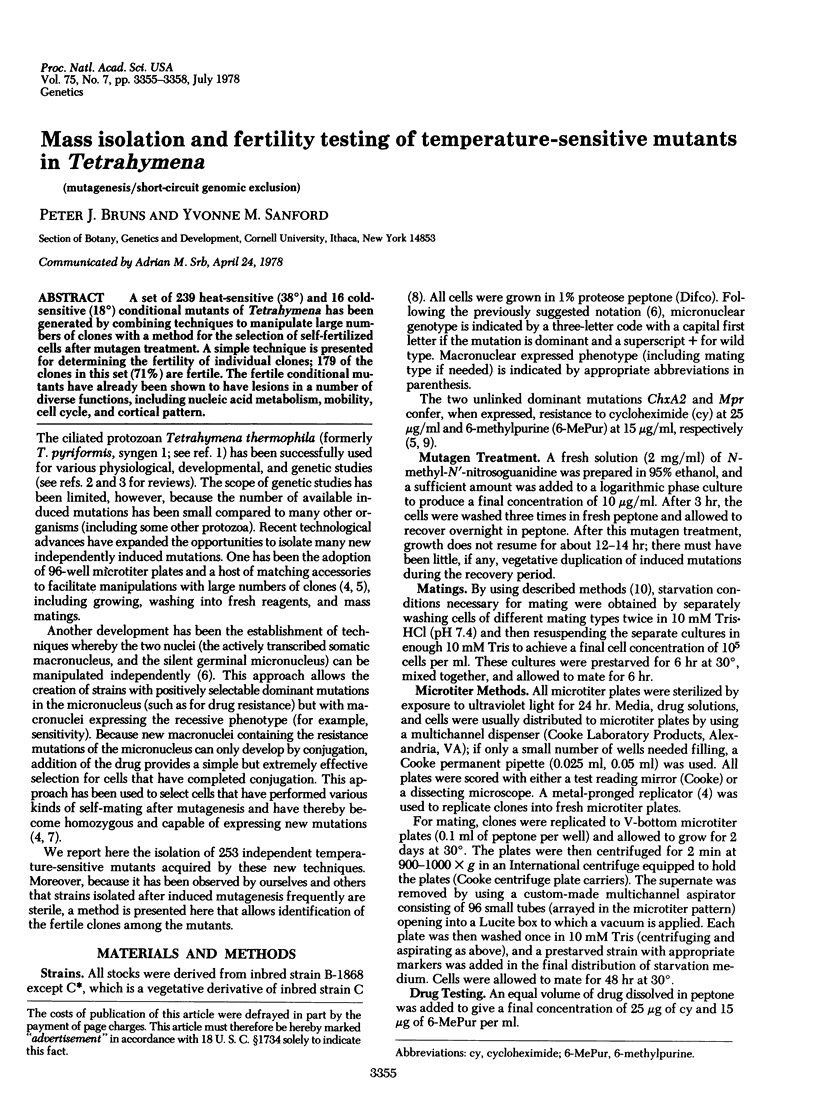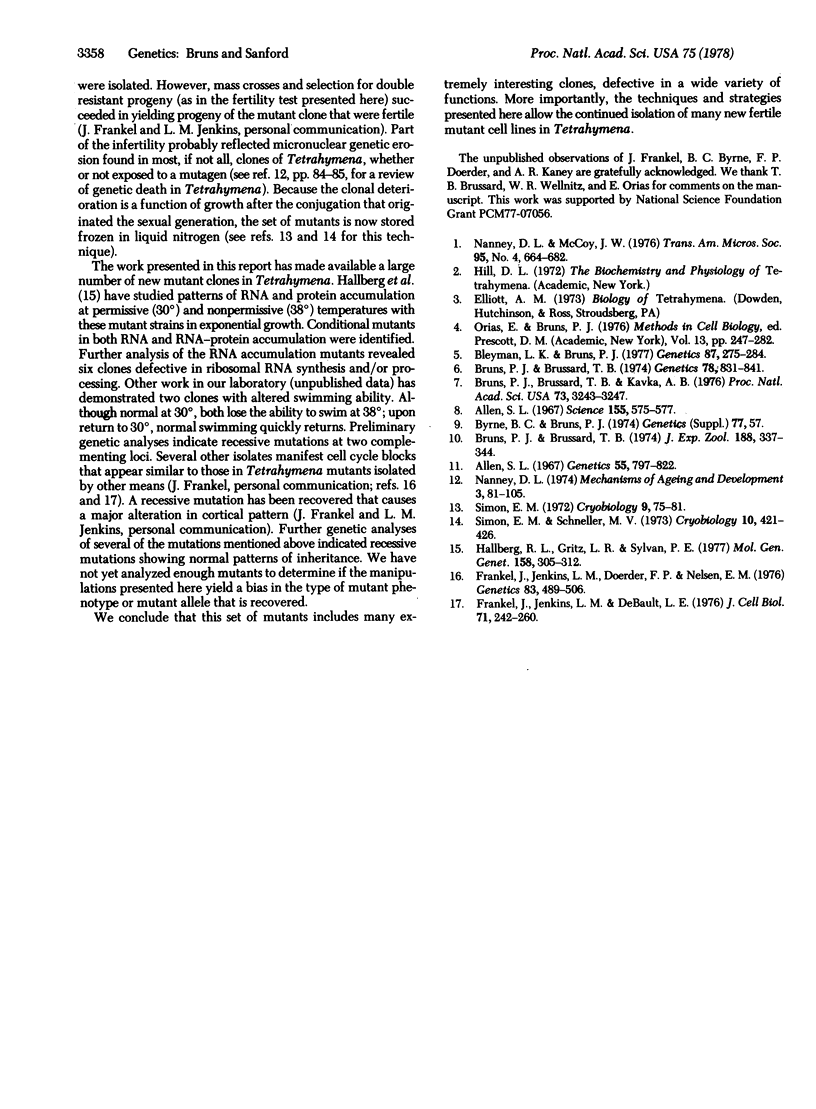Abstract
A set of 239 heat-sensitive (38 degrees) and 16 cold-sensitive (18 degrees) conditional mutants of Tetrahymena has been generated by combining techniques to manipulate large numbers of clones with a method for the selection of self-fertilized cells after mutagen treatment. A simple technique is presented for determining the fertility of individual clones; 179 of the clones in this set (71%) are fertile. The fertile conditional mutants have already been shown to have lesions in a number of diverse functions, including nucleic acid metabolism, mobility, cell cycle, and cortical pattern.
Full text
PDF



Selected References
These references are in PubMed. This may not be the complete list of references from this article.
- Allen S. L. Cytogenetics of genomic exclusion in Tetrahymena. Genetics. 1967 Apr;55(4):797–822. doi: 10.1093/genetics/55.4.797. [DOI] [PMC free article] [PubMed] [Google Scholar]
- Allen S. L. Genomic exclusion: a rapid means for inducing homozygous diploid lines in Tetrahymena pyriformis, syngen 1. Science. 1967 Feb 3;155(3762):575–577. doi: 10.1126/science.155.3762.575. [DOI] [PubMed] [Google Scholar]
- Bleyman L. K., Bruns P. J. Genetics of cycloheximide resistance in Tetrahymena. Genetics. 1977 Oct;87(2):275–284. doi: 10.1093/genetics/87.2.275. [DOI] [PMC free article] [PubMed] [Google Scholar]
- Bruns P. J., Brussard T. B., Kavka A. B. Isolation of homozygous mutants after induced self-fertilization in Tetrahymena. Proc Natl Acad Sci U S A. 1976 Sep;73(9):3243–3247. doi: 10.1073/pnas.73.9.3243. [DOI] [PMC free article] [PubMed] [Google Scholar]
- Bruns P. J., Brussard T. B. Pair formation in tetrahymena pyriformis, an inducible developmental system. J Exp Zool. 1974 Jun;188(3):337–344. doi: 10.1002/jez.1401880309. [DOI] [PubMed] [Google Scholar]
- Bruns P. J., Brussard T. B. Positive selection for mating with functional heterokaryons in Tetrahymena pyriformis. Genetics. 1974 Nov;78(3):831–841. doi: 10.1093/genetics/78.3.831. [DOI] [PMC free article] [PubMed] [Google Scholar]
- Frankel J., Jenkins L. M., DeBault L. E. Causal relations among cell cycle processes in Tetrahymena pyriformis. An analysis employing temperature-sensitive mutants. J Cell Biol. 1976 Oct;71(1):242–260. doi: 10.1083/jcb.71.1.242. [DOI] [PMC free article] [PubMed] [Google Scholar]
- Frankel J., Jenkins L. M., Doerder F. P., Nelsen E. M. Mutations affecting cell division in Tetrahymena pyriformis. I. Selection and genetic analysis. Genetics. 1976 Jul;83(3 PT2):489–506. [PMC free article] [PubMed] [Google Scholar]
- Hallberg R. L., Gritz L. R., Sylvan P. Analysis of RNA and protein synthesis in temperature-sensitive mutants of Tetrahymena pyriformis. Mol Gen Genet. 1978 Jan 17;158(3):305–312. doi: 10.1007/BF00267202. [DOI] [PubMed] [Google Scholar]
- Nanney D. L. Aging and long-term temporal regulation in ciliated protozoa. A critical review. Mech Ageing Dev. 1974 Jul-Aug;3(2):81–105. doi: 10.1016/0047-6374(74)90008-6. [DOI] [PubMed] [Google Scholar]
- Nanney D. L., McCoy J. W. Characterization of the species of the Tetrahymena pyriformis complex. Trans Am Microsc Soc. 1976 Oct;95(4):664–682. [PubMed] [Google Scholar]
- Orias E., Bruns P. J. Induction and isolation of mutants in Tetrahymena. Methods Cell Biol. 1976;13:247–282. [PubMed] [Google Scholar]
- Simon E. M. Freezing and storage in liquid nitrogen of axenically and monoxenically cultivated Tetrahymena pyriformis. Cryobiology. 1972 Apr;9(2):75–81. doi: 10.1016/0011-2240(72)90014-4. [DOI] [PubMed] [Google Scholar]
- Simon E. M., Schneller M. V. Proceedings: The preservation of ciliated protozoa at low temperature. Cryobiology. 1973 Nov;10(5):421–426. doi: 10.1016/0011-2240(73)90069-2. [DOI] [PubMed] [Google Scholar]


